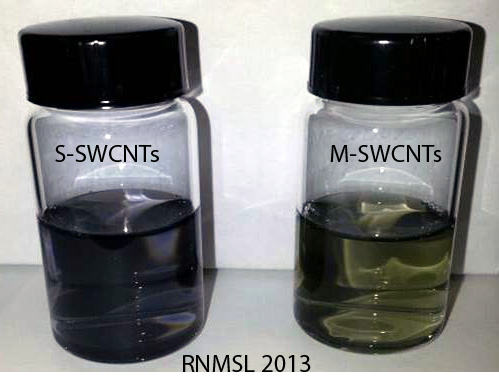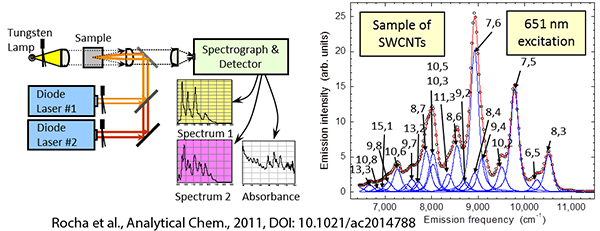SWCNTs
Primary expertise of RNMSL is in carbon-based nanomaterials.

Significant effort has centered on improving methods for producing nanotubes in large quantitites because of their unique electrical, mechanical, and thermal characteristics. The ability to realize commercial applications that utilize these distinctive properties will depend on a more comprehensive understanding of the electronic and optical properties of individual tubes in a bulk sample.
SWCNT Separations
Both production and processing of nanotubes are steadily becoming more refined. For instance, commercial sales of SWCNTs with refined diameters, (n,m) structures, and/or electronic type have been improving significantly in the past five years.

SWCNT Reactions
Many important applications of SWCNTs involve some type of functional approach to appropriately exploit the desired property. Several methods of functionalization are available including covalent non-covalent functional group attachment, the creation of hybrids by elemental coating, or enclosure by polymers. To achieve the optimal compatibility of a SWCNT sample for a particular application, it is necessary to understand the fundamental reactivities and interactions involved for all SWCNT (n,m) species. Monitoring of these reactions/interactions is readily achievable by various optical spectroscopic techniques.

Boron/carbon Nanomaterials
Another class of nanomaterials that could perform even better than SWCNTs in some applications consists of various boron nanostructures. With regard to this class of materials, the RNMSL will seek to develop both novel laser-based and solution-phase nanomaterial synthesis methods utilizing a recently proposed power amplifier laser system, building on previous work published in the literature.
Computational Chemistry
RNMSL also seeks to leverage research expertise in carbon nanomaterials with prior work experiences in computational chemistry to determine the fundamental formation pathways and oxidative reactivities of small carbon-boron molecular systems through ab initio quantum chemical calculations.
Chemistry/Higher Education
The preparation of a diverse body of future scientists & engineers depends on dedication to researching pedagogy of the field but also the methods for positive mentoring.
Broader Impacts and STEM Educational Outreach
As a Mexican-American member of RIT's African-American/Latino American/Native American (AALANA) faculty, through the RNMSL, School of Chemistry & Materials Science, and the College of Science, Dr. Rocha presently works with several campus organizations seeking to assist underrepresented minority, low socioeconomic, and female students in their research, particularly in the STEM disciplines. Students are recruited directly into the graduate student enrollment pools and high achieving undergraduates also participate via organizations such as ULSAMP (Upstate Louis Stokes Alliance for Minority Participation), COSAALANA (Community of Science AALANA) and the RIT McNair Scholars Program (a Department of Education funded program). Additionally, Rocha volunteers as a mentor for the American Chemical Society�s Project SEED program. Project SEED seeks to provide important research experiences to high school students from low socioeconomic backgrounds and underrepresented minority groups. Students in the RNMSL are active participants in student professional and fraternal societies such as ACS, Materials Research Society, and Alpha Chi Sigma.